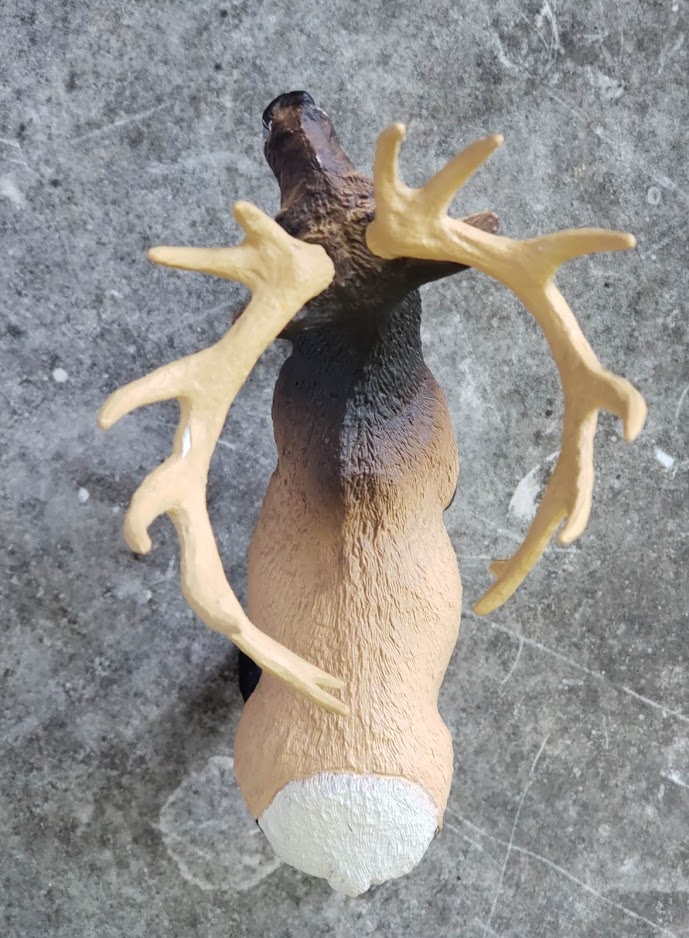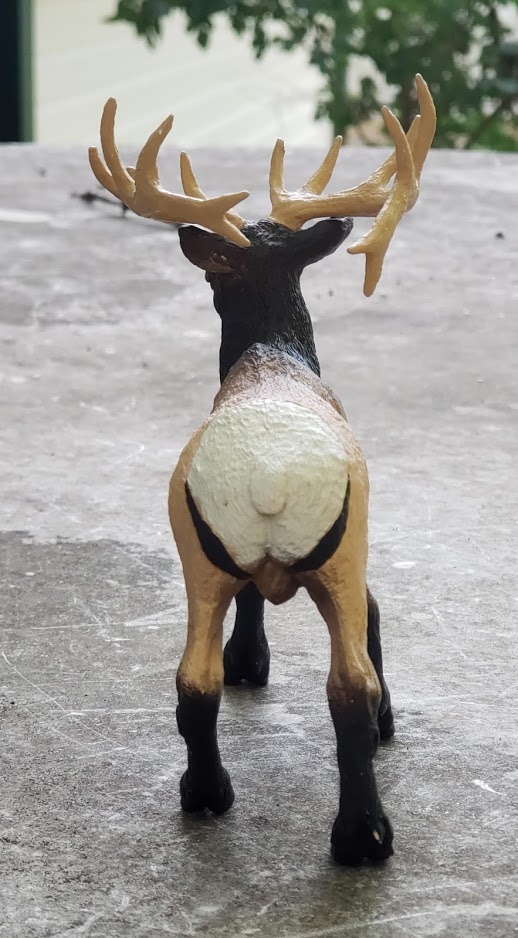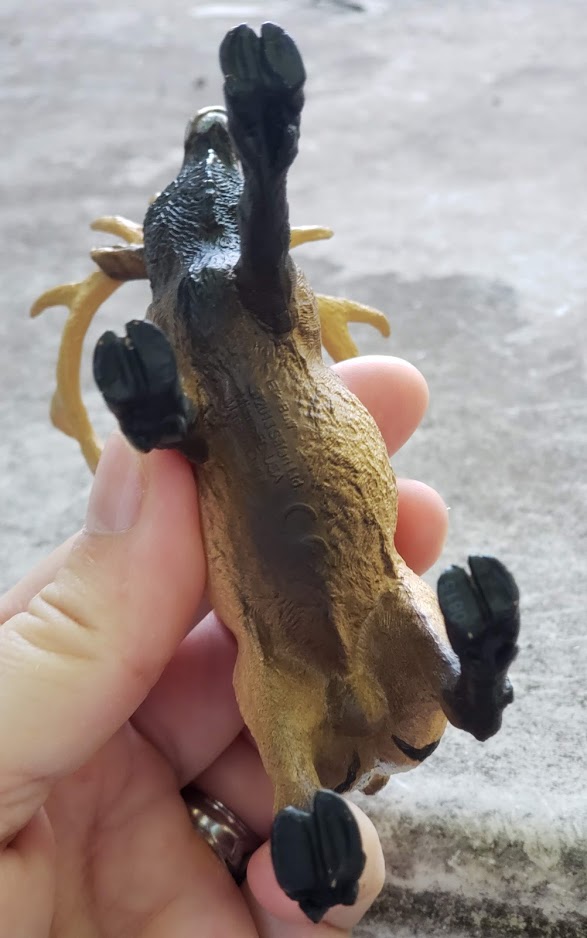Review and images by Cachalot; edited by bmathison1972
The American elk, Cervus canadensis – not to be confused with European elk, Alces alces, which is the moose of the New World. It is actually more closely related to the red deer, Cervus elaphus. It is also known as the wapiti, meaning white rump in Shawnee.
The elk is an animal of the forest edge habitat, feeding on grasses, plants, leaves, and bark. Elk can do considerable damage to the bark of trees. Bull elk sport large antlers and engage ritualized mating behaviors and fight other bulls in the autumn rut season. The bugling of a bull elk is distinctive which can be quite loud and carry quite a distance. It has been variously described as sounding thus A-A-A-Aeeeeeeeeeoh! Euh Euh Euh! I have heard this sound in person and it is bone chilling floating on cool mountain air just as the sun drops below the horizon. This call travels over open terrain, as this animal favors mixed terrain of meadow and forest. The elk is more abundant over the continental divide – the Rocky Mountains from Canada to the United States and on the North Pacific Coast is where this animal is principally found. It is also found in Eastern Asia.

The elk is a thick-bodied animal with a dark mane over the neck. This mane is more prominent in bulls. The sides are flaxen in color with the legs and belly dark brown to nearly black in some individuals. There is a pale straw colored rump patch that flares when the animal is startled. =The legs are slim and the tail short. Elk have a shoulder height of 0.75–1.5 m (2 ft 6 in–4 ft 11 in) with a nose-to-tail length of 1.6–2.7 m (5 ft 3 in–8 ft 10 in). Bulls are larger and weigh 178–497 kg (392–1,096 lb) while cows weigh in at 171–292 kg (377–644 lb). Calves are born spotted. The spots are lost by the end of summer.
The antlers are made from bone. They can grow at a rate of up to 2.5 centimeters (0.98 in) per day. During the growth phase they are covered with a protective layer of skin known as velvet. When the antlers are complete, the velvet is shed and removed through polishing the antlers. A bull elk can damage a considerable amount of real estate as he scrubs his antlers on saplings and bushes. Once polished they are typically chocolate brown on the beams with bright ivory tines. The average adult bull sports six tines per antler. On average they will be 50 inches in length and tip the scales at 12 pounds per antler. The formation and retention of the antlers is governed by the amount of testosterone in the animal’s system. In late winter and early spring when the levels of this hormone are at their lowest, the antlers are shed.
A bull is titled by the number of points he has on his antlers. If the bull has only spikes he is termed a spike bull. The following year he may carry scrawny looking antlers with four to five points. He is then called a ‘raghorn’ due to their raggedy appearance. A mature bull with six tines to a side is termed a ‘royal’. A seven point bull is an imperial. A bull with 8 or more points is termed a monarch.

The elk is most famous for his autumn rituals. During the mating season, he will gather a harem of cows and fight to keep that harem for other bulls. Outrigger bulls (bulls that circle outside around the harem) will challenge his position or try to steal members of his harem. Bull elk have even mistaken small cars for cow elk! A friend of mine had the hood of his car damaged by a bull elk when he challenged it. The engine block was cracked after this mishap.
It is the eerie bugling at sunrise and sundown that got me interested in this animal. I would drive up to Rocky Mountain National Park, where they are protected to watch and listen to them. They put on quite a show for the park guests bugling and challenging each other. Over the years I have collected a number of elk mementos, but decent looking plastic sculptures of this animal were hard to find until recently.

Now to our sculpt. He’s the best looking one I have found thus far. The figure is made from vinyl. His brown eyes are even shiny. They have the white fur in his ears. A lot of detail went into the sculpt and the paint. Many sculptures leave off the rump patch. They even have the dark border at the bottom of the patch where his hind legs join his body. Safari, from my experience, is good about having the details on the animal complete, so there is no mistake if it is a bull or a cow. This fellow has all his parts. From the front he looks magnificent. This is a bull in his September prime.
Painting him, though, they got a white drip on his nose. His antlers are where he makes a big fail. They are a uniform peach, none of that dark chocolate beam that I was writing about. Our bull’s antlers are looking faded in that respect. He would not be a ‘trophy’ bull with his antlers even though he’s an Imperial with seven tines on each antler. If you were looking for a bull with grand antlers, this isn’t your guy. When I was purchasing him, I noticed that all of the examples had the right antler beam curved in too far and bending down more than the left. He’s an atypical bull. Those antlers might get him in trouble if he were a real elk and he got into a fight.

Standing back from the sculpture. This one I would rate as convincing. If you are not looking for a bull with a perfect rack I would still give him a good rating. He would be good for a collector or an older child.

Disclaimer: links to Ebay and Amazon on the AnimalToyBlog are affiliate links, so we make a small commission if you use them. Thanks for supporting us!



